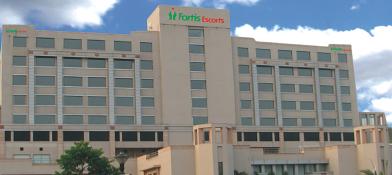Breast MRI
Why is a breast MRI done?
There are several reasons why a doctor might recommend a breast MRI.
- If you have relatives with breast cancer, regular MRI screenings can help detect early signs in you, especially at a young age, avoiding harmful exposure to X-ray radiation.
- When other scans, like mammograms, show abnormalities, an MRI can help provide a closer look to better understand them.
- If breast cancer is suspected or already diagnosed, MRI offers a detailed view of the tumors and surrounding tissue for accurate assessment.
- During cancer treatment, MRI helps monitor how well the treatment is working, providing insights into the effectiveness of the therapies.
- After tumor removal surgery, an MRI checks if the area has healed properly or if there is any sign of tumor recurrence.
Who performs a breast MRI?
Breast MRIs are typically performed by radiology technicians or technologists who specialize in MRI imaging. These professionals are trained to operate the MRI machine and ensure the patient’s safety and comfort during the procedure. Additionally, radiologists, who are medical doctors specializing in interpreting medical imaging results, analyze the MRI images and provide diagnostic reports to the referring physicians.
Preparing for the test
Preparing for a breast MRI involves simple steps to ensure a smooth experience during the procedure. It is important to wear comfortable, metal-free clothing and remove any jewelry or accessories beforehand. This is because the MRI machine uses powerful magnets to create images, and metal objects can interfere with the magnetic field, potentially causing inaccurate results or patient safety risks. Additionally, following instructions regarding eating, drinking, and medications and informing the healthcare provider about any health conditions helps ensure a successful MRI procedure. If you have anxiety or claustrophobia, communicating openly with the healthcare team beforehand can help address your concerns.
During the test
During the breast MRI, you are made to lie down on a table that slides into a tunnel-like machine. It is important to stay still while the machine takes pictures of your breasts. The procedure is painless, but you may hear loud noises from the machine. If you are uncomfortable or anxious, let the healthcare team know. They can provide mental support to help you feel more comfortable.
After the test
After breast MRI, you can usually return to your normal activities right away. If you were given a contrast dye injection, drink plenty of fluids to help flush it out of your system. The MRI images will be reviewed by a radiologist, who will share the results with your doctor. Your doctor will then discuss the findings with you and any subsequent steps that may need to be taken.
Risks associated with breast MRI
While breast MRI is generally considered safe, there are some risks and considerations to be aware of.
Allergic reactions: Some people may exhibit an allergic reaction to the contrast dye used during the MRI, although this is rare. If you have had an allergic reaction to the contrast dye in the past, be sure to inform your healthcare provider beforehand.
Claustrophobia: Being inside the MRI machine can be uncomfortable for some people, especially those who are claustrophobic. If you are prone to claustrophobia, inform the healthcare team beforehand. They may provide strategies or medications to help you feel more comfortable during the procedure.
Metal implants or devices: Certain metal implants or devices in the body, such as pacemakers, cochlear implants, or metallic fragments, may be affected by the strong magnetic field of the MRI machine. Inform your healthcare provider if you have any metal implants or devices, as they may recommend an alternative imaging technique or take precautions to ensure safety.
Pregnancy: While there is no evidence to suggest that MRI harms the fetus, it is generally avoided during pregnancy, especially during the first trimester.
Kidney function: If contrast dye is used during the MRI, there is a small risk of kidney damage, particularly in people with pre-existing kidney problems.
Overall, while these risks are rare, it is important to discuss any concerns with your healthcare provider before undergoing a breast MRI. They can guide you well based on your health situation.
Interpreting result
Radiologists, or doctors with specialized training in interpreting medical images, are usually the ones who interpret the results of a breast MRI. Your healthcare practitioner will receive a comprehensive report from the radiologist once they have examined the MRI images of your breasts.
The findings could include benign (non-cancerous) abnormalities like cysts or fibroadenomas, or they could reveal potentially malignant tumors in addition to normal breast tissue. If anomalies are found, the radiologist will describe the size, shape, and position of the abnormalities and may suggest additional testing or follow-up procedures, like a biopsy or more imaging scans.
You can then have a discussion with your healthcare professional about the results and their implications for your health. Further therapy or monitoring may be advised based on the results. It is critical you follow your healthcare provider’s instructions for the next stages and ask any questions you may have.
Contact Fortis Healthcare to learn more about breast MRIs.
FAQs
- How long does a breast MRI take?
A breast MRI usually takes about 30 to 60 minutes to complete, depending on the specific protocol and whether contrast dye is used.
- Will the breast MRI hurt?
No, a breast MRI is painless. You may hear loud noises from the MRI machine, but you will not feel anything during the procedure.
- How will I be positioned for my breast MRI?
You will be made to lie face-down on a padded table with your breasts positioned through an opening. Your arms may be placed above your head or by your sides, depending on the machine and your comfort.
- What is it like inside the machine?
An MRI machine resembles a large tube or tunnel. It is well-lit and ventilated, but it may feel a bit narrow or confined. Some people may feel claustrophobic, but healthcare providers can offer strategies or medications to help you feel more comfortable.
- Do I have to get an injection?
During the MRI, a contrast dye may be injected into an arm vein to improve the quality of the images. This is usually done if your healthcare provider needs more detailed information.
- What about false positives?
Sometimes, breast MRI can result in false positives, meaning that abnormalities shown in the result may not indicate cancer after further examination. Although this may lead to needless worry and more testing, medical professionals try to reduce this likelihood and properly interpret the findings.



















